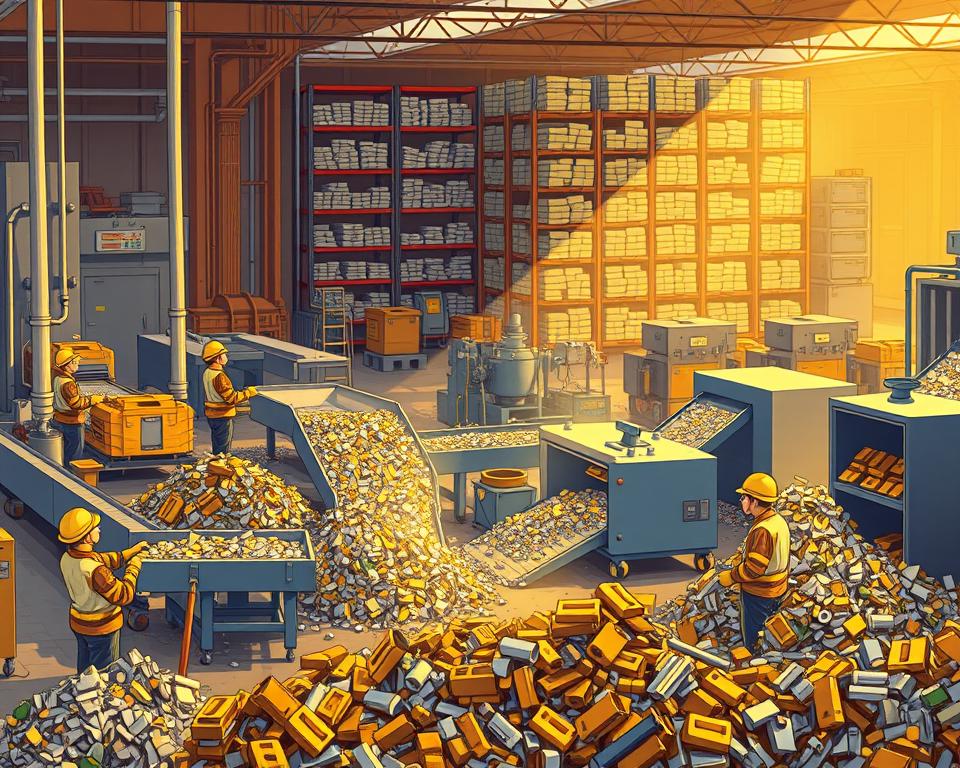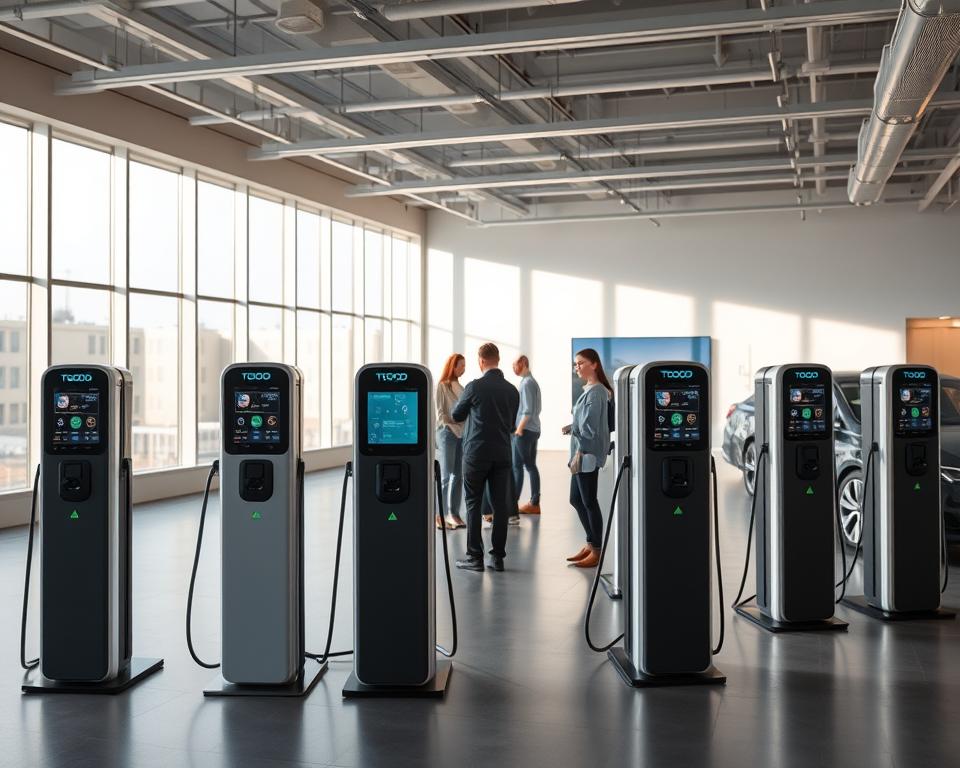Your Sustainable Precious Metal Recycling Guide
Did you know that more than $60 billion worth of precious metals are discarded each year in electronic waste alone? This staggering figure underlines the critical role of precious metal recycling. It’s not just good for our economy but also for the environment. Reclaiming gold, silver, platinum, and palladium helps lower pollution and preserve what’s left of our natural resources.
Firms like Dongsheng Metal Trading spearhead the movement toward greener recycling. They ensure these valuable metals are reused, not dumped in landfills. That precious metal recycling companies strategy underpins green recycling and long-term sustainability.
Major Takeaways
- Each year, e-waste discards over $60 billion in precious metals.
- Precious metal recycling reduces environmental impact and conserves resources.
- Valuable metals include gold, silver, platinum, and palladium.
- Sustainable development depends on eco-friendly recycling.
- Companies like Dongsheng Metal Trading specialize in metal recycling.
What Makes Precious Metals So Valuable
Naturally scarce metallic elements called precious metals draw interest from industries and investors. Gold, silver, platinum, and palladium are prime examples, known for their unique properties. These include electrical conductivity, corrosion resistance, and substantial rarity. Extracting and refining them uses up huge resources, so recycling becomes critical.

Intrinsic qualities and demand in the marketplace determine precious metals’ worth. Recovering metals is key to keeping the supply chain alive. It cuts the environmental toll of mining operations. By thorough recycling, these metals return to their pure form. This preserves finite resources while yielding economic benefits.
What are Precious Metals?
Unique features make precious metals ideal for many uses. Their rarity and intrinsic properties are foundational to their economic significance. Key examples include:
- Gold: Valued for its beauty and resistance to tarnish.
- Ag: Known for flexible uses and excellent conductivity.
- Pt: Renowned for strength and catalytic uses.
- Palladium: Gaining traction in cars and electronics.
Benefits of Precious Metal Recycling
The practice of recycling precious metals has emerged as a vital component for sustainability. It saves scarce materials and sharply cuts mining’s eco-footprint. Key benefits include:
- Lessening of habitat destruction from mining.
- Energy needs are far lower than mining virgin ore.
- Contribution to a circular economy by reintroducing materials into production cycles.
- Potential for financial gains through the reclaiming of high-value materials.
Impact of Recycling Precious Metals
Recycling precious metals offers substantial environmental and economic benefits. Pointing out these perks shows how to shrink our eco-impact. It also drives economic growth and stability.
Environmental Benefits
Recycling metals yields major environmental perks. By reclaiming metals from discarded electronics and industrial scrap, we cut down on landfill waste. This reduces the need for new mining, conserving natural resources.
It curtails mining’s damage, like habitat loss and toxins. A focus on metal recovery moves us toward real sustainability.
Financial Gains
The economic benefits of recycling are equally compelling. Recovering metals cuts production expenses. That shift enables firms to opt for recycled rather than virgin metals.
It produces recycling-sector employment and strengthens markets with growing recycled-metal needs. Using these financial benefits, companies can improve profits. They also contribute to a greener economy.
How Precious Metals are Recycled
The precious metal recycling process is complex, involving several stages to ensure maximum efficiency. First, scrap electronics, jewelry, and industrial waste are gathered. Next comes sorting, cleaning, and testing to assess metal content and worth.
Recycling Workflow
This systematic approach is vital for effective metal recovery. All stages focus on boosting metal yield. Sorting separates metals by type and purity. Cleaning strips away impurities that impede extraction. Analysis identifies the concentration of precious metals, guiding the choice of recycling techniques.
Recycling Techniques Used
Cutting-edge processes boost precious-metal recovery. Thermal reduction applies intense heat to isolate metals. Molten refining and wet-chemistry steps handle finer separations. Firms such as Dongsheng Metal Trading apply these techniques to raise recovery and profits.
Types of Precious Metals that can be Recycled
Recovery efforts support both ecology and resource reclamation. Many precious metals can be recycled, benefiting both the economy and the planet. Knowing which metals are recyclable helps individuals and firms.
Gold, Silver, and Platinum
Gold, silver, and platinum stand out among precious metals. They appear in jewelry, coinage, and industrial components. Gold recovery is widespread because of its worth and need. Silver’s role in cameras, electronics, and solar energy makes its recycling vital.
Though scarcer, platinum’s worth shines in auto catalysts.
Rare Metals in Electronics
Electronics scrap contains metals ripe for recovery. Devices such as phones and computers hold palladium and indium. Recovering such metals diminishes e-waste and yields vital materials.
It’s crucial to recover these electronic metals. Sectors strive to cut waste and boost recycling efficiency.
Industry Benefits of Precious Metal Recovery
Metal recovery underpins major sectors by supplying reclaimed resources sustainably. Electronics, which embeds metals in gadgets, gains the most. Aerospace and healthcare rely on them for vital parts. Exploring how these industries recycle precious metals reveals the environmental and economic benefits.
Tech Electronics
The electronics industry leads in precious metal recycling due to the abundance of valuable metals in devices like smartphones and computers. Rapid technological advancements have led to a significant increase in electronic waste. Hence, recovering metals like gold, silver, and palladium is crucial. It preserves nature and lowers mining-driven CO₂ emissions.
Companies are increasingly focusing on recycling to meet global sustainability and waste reduction goals. That change bolsters resource saving and ecosafety.
Aerospace & Medical
Recycling precious metals matters for aerospace and healthcare, given their reliance on them. Durable, corrosion-resistant alloys are used in aircraft and medical tools. Metal recovery slashes expenses and ensures eco-compliance.
These sectors know green recovery eases resource shortages. It also enhances operational efficiency, making recycling a key strategy for sustainability.
How to Choose a Metal Recycler
Locating reliable recycling partners ensures great results. Be sure to quiz them on their methods. Their fees and techniques will shape your outcome. Reviewing offerings lets you select wisely.
Key Questions for Recyclers
- Which recovery certifications does your company have?
- How do you process various precious metals?
- Which recovery percentages do you achieve for each metal?
- How do you handle pricing, and what additional fees might apply?
- Do you have client testimonials or references?
Comparing Prices and Services
You must evaluate services side-by-side to pick the right recycler. Use a table to line up these factors:
| Company Name | Recovery Rate (%) | Processing Fee ($) | Turnaround Time (Days) |
|---|---|---|---|
| Recycling Co. A | 95 | 50 | 7 |
| Recycling Co. B | 90 | 45 | 5 |
| Recycling Co. C | 92 | 55 | 10 |
Side-by-side comparisons help pinpoint the ideal recycler. This ensures you get the most value and meet industry standards.
Your Metal Recycling Handbook
Understanding how recyclers operate is key for those interested in precious metal recycling. They handle all stages, from gathering to final refining. This ensures maximum efficiency and value from metals.
How Recyclers Operate
Advanced workflows—assay, separation, smelting—unlock metal value. They start by collecting metal scraps from various sources. Afterwards, they apply refined techniques to isolate each metal. Finally, they refine each batch to recover gold, silver, platinum, etc.
This process not only maximizes resource recovery but also supports eco-friendly practices. It’s a critical step towards sustainable development.
Choosing the Right Recycler for Your Needs
Key criteria matter when choosing a recycler. Start with their sustainability track record. A focus on sustainability is non-negotiable. Also, consider the services they offer, from basic collection to full processing.
Pricing is another key factor. Get quotes to compare different options. Companies like Dongsheng Metal Trading offer customized solutions for various industries. They stand out as dependable recyclers.
Types of Recycling Facilities
Recycling centers play a key role in sustainability and waste control. It encompasses various recycling centers, each tailored to specific metal recovery needs. Awareness of facility types guides you to proper recyclers. That supports firms and ecosystems alike.
Facility Categories
There’s a broad spectrum of recycling operations. Some focus on precious metals, while others handle a wide range of materials. Common examples include:
- Metal Scrap Yards: Typically focus on general metal waste, including ferrous and non-ferrous metals.
- High-value metal recyclers provide precision recovery for gold, silver, platinum, etc.
- E-Waste Recycling Centers: Specialize in recovering metals from discarded electronics, capitalizing on the valuable components often found in these devices.
Facility Access Factors
Easy access to facilities boosts recovery efficiency. Businesses must consider the logistics of transporting materials. Here are some factors that influence access:
| Factor | Description |
|---|---|
| Proximity | Facilities located nearer to businesses minimize transportation costs and time. |
| Networking | Having established relationships with local recyclers can enhance efficiency in recycling processes. |
| Services Offered | Understanding the specific services of metal recycling facilities helps businesses select appropriate partners. |
In sum, selecting the right type of recycling center and ensuring convenient access can significantly enhance the efficiency of metal recycling operations.
E-Waste Recycling & Metal Recovery
E-waste poses a major ecological challenge. Many e-waste items hold recoverable precious metals. It shows why we should treat e-waste as treasure.
Metals in Devices
Gadgets harbor small quantities of precious metals. These metals are found in various parts:
- Circuit boards
- Connectors and ports
- Capacitors and resistors
- Battery terminals
From phones to TVs, electronics pack precious metals. With recycling, we can efficiently recover and reuse them.
E-Waste Recovery Benefits
Recovering e-waste metals safeguards the environment and reclaims materials. That cuts landfill volume and conserves resources. The benefits of recycling e-waste metals are clear:
- It lowers pollution risks tied to discarded electronics
- It cuts down on carbon emissions through eco-friendly practices
- It supports the circular economy by recycling materials back into production
Encouraging electronic recycling promotes sustainable resource management. It secures a healthier planet for tomorrow’s children.
The Future of Precious Metal Recycling
Metal recycling is evolving, spurred by tech advances and green initiatives. With resource conservation rising, recyclers are innovating. By integrating novel processes, they pave the way forward.
Trends in Sustainable Recycling
Current trends in sustainable recycling focus on reducing waste and minimizing environmental impact. Firms now use bio-packaging and low-energy methods. That evolution supports global green targets and fosters industry responsibility.
Cutting-Edge Recovery Methods
New methods in recovery enhance recycling performance. New technologies, such as automated sorting and hydrometallurgical extraction, enhance recovery rates. These innovations not only increase resource extraction but also reduce environmental impact, marking a significant step forward in recycling precious metals.
Starting a Precious Metal Recycling Venture
Building a metal recycling enterprise calls for thorough planning and industry knowledge. Entrepreneurs must outline key steps to build a strong foundation and adhere to industry regulations. This includes conducting extensive market research and identifying target clients. Permits and regulatory clarity underpin ongoing success.
Launching Steps
To launch your recycling venture, follow these steps:
- Analyze market demand and competitor landscape.
- Draft a strategy blueprint covering targets and methods.
- Purchase the right gear for your recycling operations.
- Secure funding through loans or investments.
- Get all required permits and licenses.
- Implement a marketing strategy to draw in customers.
Regulatory & Certification Needs
Grasping legal frameworks is essential for your recycling venture. Adherence to environmental regulations ensures your operation is safe and sustainable. Key considerations include:
- Obtaining official certification from governing bodies.
- Following all levels of waste and recycling regulations.
- Certifying employee knowledge of safety and handling rules.
In Closing
Recovering precious metals conserves resources and protects our planet. It allows individuals and businesses to lessen waste’s impact on our planet. The recovered metals reduce mining needs and boost the economy by creating jobs in recycling.
Metal recovery delivers both eco and economic upsides. Working with Dongsheng Metal Trading guarantees green standards. This collaboration strengthens the circular economy, benefiting both recyclers and consumers.
The journey to a sustainable future depends on collective action in recycling precious metals. Growing awareness can lead to a society that values responsible consumption and environmental care. Adopting these practices will benefit us now and secure a greener future for generations to come.


